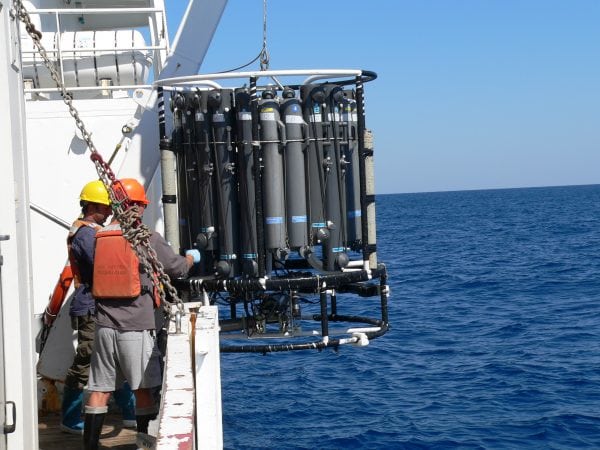
Methane is an important ‘greenhouse gas’; that is, a gas that plays a role in earth’s heat balance and hence our climate. In fact, molecule for molecule, methane is more effective at trapping heat than carbon dioxide. Thus, although there is currently about 200 times more carbon dioxide in the atmosphere than methane, there is nonetheless keen interest in the scientific community to understand the sources and sinks of methane to the atmosphere. Dr. Alan M. Shiller has made this a focus of his career in recent years.
As it turns out, substantial reservoirs of methane exist in marine sediments and this methane could be released from the sediments with ongoing warming of ocean waters. If the released methane makes its way through the ocean and reaches the atmosphere, then its heat-trapping properties could exacerbate climate change. Indeed, massive release of methane from the seafloor has been implicated in past climate change. There are, however, bacteria in ocean waters known as methanotrophs that use methane as their food source. If these methanotrophs can consume oceanic methane quickly enough, then most of the methane flux out of the sediments might not get to the atmosphere.
The Deepwater Horizon blowout in the northern Gulf of Mexico in 2010 is well-known as an ‘oil spill’. However, about half of the hydrocarbon material that came out of the wellhead was not crude oil but rather was natural gas, primarily composed of methane. This methane accumulated in submerged plumes about 1100 m (3600 ft) deep in the ocean. This served as an ‘unplanned experiment’ to test what might happen during the release of substantial amounts of methane from marine sediments. What was observed and published by several groups of scientists was that the methanotrophs bloomed and consumed the methane in the submerged plumes far more rapidly (in months rather than years) than had been expected. This suggests that methane released from marine sediments in response to climate change might have a muted impact on the atmosphere.
Rare Earth Elements After Deepwater Horizon
Around the time that the work on the Deepwater Horizon microbial bloom was published, a Dutch group also published work on a new type of methanotrophy that they discovered while studying the famous volcanic mudpots at Solfotara near Naples, Italy. A key enzyme in methanotrophy, methanol dehydrogenase or MDH, usually requires calcium ions for activity. But in the mudpots at Solfotara organisms were found that required rare earth elements rather than calcium in their methanol dehydrogenase. The rare earths (also known as lanthanide elements), are a group of elements commonly shown as the upper of two extra rows placed below the main part of the periodic table. The term ‘rare earth element’ is actually a bit of a misnomer since some of these ‘rare’ elements are as common in the earth’s crust as other better known elements like copper and lead. In fact, many of the rare earths have found important uses in the modern industrial world. For instance, in a hybrid car there can be pounds of the elements lanthanum and neodymium in the car’s hybrid battery and electric motor.

Deployment of water sampling bottles (Alan M. Shiller)
Considering together the observations of Deepwater Horizon methane consumption and this newly observed rare earth requiring mechanism of methanotrophy, we decided to see if rare earth element distributions were affected during the blowout. We were able to do this because we had collected samples suitable for trace element analysis both during and after the event. And, we did observe significant depletions in lanthanum and some of its periodic table neighbors during May/June 2010 (that is, during the blowout) but not a year and a half later when methane concentrations were back to their natural, very low concentrations. Next, using a mesocosm system we developed for studying methanotrophy, we incubated water samples collected at a natural seafloor methane seep about 10 miles (17 km) northwest of the Deepwater Horizon site. Once again we observed a depletion of lanthanum and some of its neighbors during methane consumption. Furthermore, we were able to detect expression of the gene that encodes for the rare earth element requiring enzyme.
Now, this may all seem like a minor academic point. After all, the Deepwater Horizon methane was rapidly consumed….what else do we need to know? One reason this is important is that it’s the first time rare earth elements have been found to be important in any oceanic biological process. Indeed, until the work of the Dutch group, the rare earths were generally thought to be biologically unimportant. But, because these elements are found in only parts-per-trillion concentrations in the ocean, our work shows that their availability plays an under-appreciated role in the removal of methane from the ocean and hence an uncertain role in control of this important greenhouse gas. Furthermore, because oceanographers had assumed that the rare earths were not bioactive, we need to re-examine our interpretations of their distributions and see if we can come to an improved understanding of what the rare earth elements are telling us about ocean processes.

Sunset in the Gulf of Mexico (Alan M. Shiller)
The Role Of Rare Earth Elements In Marine Ecosystems
All of this leaves us with two interesting questions. The first question is why would organisms evolve to need these elements that are in such low concentrations in seawater? We can only speculate on the answer, but there are probably several important factors. First of all, rare earth element ions have some chemical similarity to the calcium ions which are more commonly found in enzymes such as MDH. Additionally, the rare earths actually possess some chemical properties that make them potentially better catalysts than calcium. Methanotrophy is thought to be one of the oldest metabolic pathways. So, it may well be that methanotrophy first evolved in an environment more rich in rare earths than today’s ocean. Indeed, the hydrothermal systems at Solfotara have dissolved rare earth element concentrations 40,000 times higher than seawater at the Deepwater Horizon site and hydrothermal systems are often observed to have significant dissolved methane. So the enzymatic rare earth element requirement may well have developed in an environment in which these biochemically desirable elements were more available than in today’s ocean. This also suggests there may well be other rare earth element utilizing enzymes waiting to be discovered. Indeed, there is already a published report of an ethanol dehydrogenase that requires lanthanides for activity.
Finally, can we return to the question of the fate of large amounts of methane released from marine sediments? We observe, for instance, that the inventory and residence time of lanthanides in today’s ocean is of a magnitude similar to what methanotrophs might have required 55 million years ago during a climatic event known as the Paleocene-Eocene Thermal Maximum (PETM). The PETM is thought to have resulted from a large change in the carbon system possibly due to a massive release of methane from marine sediments. Because of the chemical similarity between the lanthanides and calcium, there is likely a record of ocean lanthanide concentrations stored in the calcium carbonate shells of certain unicellular organisms (foraminifera) and buried in the marine sediments. This could give us the means to examine the hypothesis of massive sedimentary methane release during the PETM through its effect on lanthanides and thus provide insight into mechanisms of climate change in the geologic past.
This study, Light rare earth element depletion during Deepwater Horizon blowout methanotrophy, was recently published in the journal Scientific Reports.









